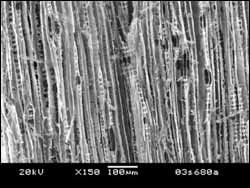Materials management deals with the research, development, manufacturing and processing of raw and industrial materials. Key aspects here are biological and medical issues, which play an increasingly important role in this field.
innovations-report offers in-depth articles related to the development and application of materials and the structure and properties of new materials.

Device features on computer chips as small as 40 nanometers (nm) wide–less than one-thousandth the width of a human hair–can now be measured reliably thanks to new test structures developed by a team of physicists, engineers, and statisticians at the Commerce Department’s National Institute of Standards and Technology (NIST), SEMATECH, and other collaborators. The test structures are replicated on reference materials that will allow better calibration of tools that monitor the manufacturing of

Advance helps in arrythmia research
Scientists at Washington University in St. Louis have developed the first mathematical model of a canine cardiac cell that incorporates a vital calcium regulatory pathway that has implications in life-threatening cardiac arrhythmias, or irregular heartbeats.
Thomas J. Hund, Ph.D., post-doctoral researcher in Pathology ( in Dr. Jeffrey Saffitz laboratory) at the Washington University School of Medicine, and Yoram Rudy, The Fred Saigh D

Or tell you when it’s time to reel in that big fish
In a world with an intensified need for security, Case Western Reserve University researchers are developing materials that could make consumers less susceptible to product tampering or failures. Using a mixture of conventional polymers with small amounts of tailored fluorescent dyes, Case researchers have discovered that the dyes function as natural, molecular sensors, creating light-emitting polymer blends that show mechanical s

The problem of the tribological behaviour of materials had focussed on either improving friction or prioritising less wear and tear. The target of FOREMOST project (“FOREMOST: fullerene-based opportunities for robust engineering: making optimised surfaces for tribology”) is to achieve both effects simultaneously and, tot his end, the project will be based on the use of inorganic fullerenes (molybdenum bisulphate and bisulphate of wolframite). These new alotropic states of these well-known soli

Pacific Northwest National Laboratory scientists can mineralize wood in record time
California has Silicon Valley. Could a Silicon Forest in Washington be next? A team of materials scientists from Pacific Northwest National Laboratory is on it.
Yongsoon Shin and colleagues at the Department of Energy lab have converted wood to mineral, achieving in days what it takes nature millions of years to do in such places as the Gingko Petrified Forest, an hour up the Columbia Riv

Ohio State University engineers are designing super-slick, water-repellent surfaces that mimic the texture of lotus leaves.
The patent-pending technology could lead to self-cleaning glass, and could also reduce friction between the tiny moving parts inside microdevices.
Scientists have long known that the lotus, or water lily, makes a good model for a water-repellent surface, explained Bharat Bhushan, Ohio Eminent Scholar and the Howard D. Winbigler Professor of mechanical